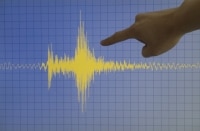On the heels of yesterday’s report detailing Cuadrilla Resource’s admission that their fracking practices were responsible for small earthquakes in the U.K., new reports are surfacing that link fracking to earthquakes that occurred in January in Oklahoma. According to a new study by the Oklahoma Geological Survey [PDF], fracking is linked to 50 mini-earthquakes that occurred on January 18, 2011 in Oklahoma.
The NRDC describes the events as follows:
The occurrence of so-called “induced seismicity” – seismic activity caused by human actions – in conjunction with fluid injection or extraction operations is a well-documented phenomenon. However, induced earthquakes large enough to be felt at the surface have typically been associated with large scale injection or withdrawal of fluids, such as water injection wells, geothermal energy production, and oil and gas production. It was generally thought that the risk of inducing large earthquakes through hydraulic fracturing was very low, because of the comparatively small volumes of fluid injected and relatively short time-frame over which it occurs. As the controversy over hydraulic fracturing has heated up, however, researchers and the public have become increasingly interested in the potential for fracking to cause large earthquakes.
But this is hardly a new phenomenon. Studies show that fracking practices in the 1970s had caused similar seismic activity in Oklahoma, according to E&E News.
To date, none of the quakes have caused any deaths or any significant damages, but Grist echoed a great point from Joe Romm: “Would we tolerate this sort of impact from any other sort of industry? Would we tolerate it from a renewable energy industry? The answer there is no.”
As the pressure heats up over fracking, these seismic events will certainly become a cause for concern, and possibly even litigation, for citizens who are already unhappy with fracking activities occurring in their backyards.
Subscribe to our newsletter
Stay up to date with DeSmog news and alerts







